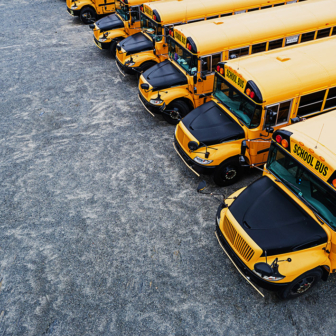The first thing I did when I became a secondary school principal many years ago was to put the school’s prefects in blazers and ties. The school was losing enrolments and needed to improve its profile; prefects were put in the vanguard of our efforts to win back a critical mass of aspirant families. The second thing was to invite Sydney University educationalist David Smith to speak to the staff. Even then, David was ahead of his time, delivering a telling critique of what he saw as outdated industrial-era schooling and a strong case for more personalised learning.
The first was a cosmetic change we needed to stay viable. Pursuing desirable students, and the benefits they bring, is common enough among schools in a competitive environment. The second was more challenging and risky; it meant reshaping the school and who it served, and could be far more significant if it worked.
What to do, and how far to go? To me, the most innovative schools seemed to fall into two categories: high-demand schools that could do no wrong, and low-demand schools that had nothing to lose. It was true up to a point, but I mistakenly consigned much of what they did to the fringes of schooling. What schools like mine did to lift engagement and retention was to tweak the system by introducing a more diverse curriculum, including vocational education. It was quite successful, as far as it went — but it didn’t go far enough.
After I retired I visited a number of innovative schools and always walked away not only with admiration for the energy of school leaders and teachers, but also with a greater awareness of the institutional, cultural and micro-political constraints on what they wanted to do. As a part-consequence, the innovations, just like mine, tended to be added to what was considered the main work of schools rather than changing how we do schooling itself. And the diversity I saw was as much about schools positioning themselves in the market as it was about catering for differences in student learning.
Two big things have changed over the years, and both have implications for where we go next. The first big change comes from our decision to allow, and even encourage, students with ability and advantages to gravitate to schools with similar students — not just in private schools but also in certain government schools. The flipside is that we have compounded disadvantage in other schools, and increased the challenge of improving their experience and performance. The late Bernie Shepherd and I have put numbers on this trend. It is incremental but alarming, and not much can improve if we don’t reverse it.
But it is the second change that is the focus of this article. There’s ample evidence of a serious disconnect exists between young people and their schools. The Mitchell Institute has detailed the extent of the problem at various stages of schooling, and the Grattan Institute concludes that as many as 40 per cent of school students are unproductive in a given year.
While it is rarely stated in these terms, the problem of disengagement lies behind many of our efforts to improve student outcomes, the latest big effort being the second Gonski review. When the review panel asked us what students need to learn at school, my first thought was to come up with an erudite list of capabilities, skills and knowledge. But if students aren’t engaged in learning then not much else will happen, and we will always fall well short of our most treasured goals.
This sent me back to what David Smith talked about decades ago. Maybe the real question is whether game-changing innovation can take hold if schools still look decades old. Lock-step student progression; siloed learning driven by externally created curriculum; exquisitely designed and imposed assessment hoops through which students must jump on command — it could well be that these features of schooling are blocking the innovation we need.
Has anyone managed to do it differently? Some schools tick all the boxes for the critics of the current system, producing students who are engaged, equipped and successful. “One student at a time in a community of learners,” as one group of schools puts it. Learning is designed around characteristics that are proven, in combination, to be essential for student engagement. These are the Big Picture schools that I first saw in operation in the United States, a country where I’ve seen the very best and the most ordinary of schools. Over the past decade, Big Picture schools, both government and non-government, have expanded in Australia, especially in New South Wales, Western Australia and Tasmania.
My lasting impressions of these schools include memories of the students who told me about what they were doing, in language of learning and purpose that I have rarely heard in a mainstream school. I won’t forget the Big Picture school in a poor area, without a fence, untarnished by graffiti and vandalism, an island of pride and hope in a neighbourhood of despair. And it was a great experience to be in these schools with teachers who were probably working harder but didn’t want to go back to what it was like before.
For students between years nine and twelve, Big Picture schools bring together a future focus, academic rigour, real-world learning, collaboration and participation. The approach is highly personalised and built on the student’s own passions. Relevance is maintained by links between schools and workplaces: students spend up to two days a week in an interest-based, curriculum-linked internship with a mentor from the community. It is a fundamental redesign of learning.
The significance of these schools is not that they will or should supplant mainstream schools. It’s the fact that their very existence urges a rethink of how we do schooling, and who benefits and who misses out. The questions framed by the current Gonski review were aimed at encouraging people to rethink what they were doing, contemplate what they wanted and state what gets in the way. Even the federal minister urged us to “think outside the square” — but more on that later.
Gonski asked us what students need to learn at school and how their achievement can be measured. Any educator can come up with a list of what should be learnt, though it will be hard to make real progress without authentic student engagement. The sting in the tail is the second part of the question: how do we measure achievement? If there is any aspect of pedagogy that is ripe for change it is the system of external assessment, which stifles student engagement and in-depth learning.
Gonski also asked what we can do to improve learning for all students. We’re starting from a position where schools manifestly don’t serve all students. They come to school with a diversity of personal resources, interests, abilities and learning styles; there is no guarantee — and in many cases not even the remotest possibility — that the schools available to them will maximise their potential to achieve their best. It is a substantial and unacknowledged equity problem, one that touches young people across the socio-educational spectrum and should be a major target of the review’s recommendations for innovation.
Gonski has asked us to be specific about what works and what gets in the way. This brings me back to the minister’s entreaty for those of us writing submissions to think outside the square. The idea of a square is a perfect metaphor to describe the boundaries within which schools operate. The boundaries, the four sides, are patrolled by people and forces that act to keep schools contained and conventional.
Forming one of these boundaries are the decisions of governments, schools and related authorities. These include the requirements imposed by curriculum and testing authorities; government decisions, both proactive and reactive, about priorities for school reform; and processes of accountability. The Gonski panel calls them enablers, but they don’t seem to enable, or at least encourage, deep innovation. Narrow measures of student worth and achievement can especially undermine the great things schools do, and distort the purpose of schooling itself.
Forming a second boundary are the public’s views about what constitutes a desirable and successful school. They include inherently conservative, recycled and often dated ideas about schools — and are reflected in much media reporting of how schools should be judged.
The third boundary is created by a market culture that drives competition and choice, and seems to inhibit risk-taking innovation. Bringing market forces into education has meant that schools are more similar than most people imagine: only the brave stray beyond the expected look and feel. It’s time we called out school competition for what it is: a failed policy that has created and further divided winners and losers.
But not all the problems are external. The fourth boundary is the culture within which some schools and school systems operate. School leaders work hard to introduce improvements but are often handicapped by pockets of conservatism and inertia in the teaching profession — and certainly not helped by ill-advised initiatives from governments and school authorities. It takes a special school leader to overcome external constraints and the lack of trust in the system among teachers.
We have reformed schools for decades, pitched them into competition and tested them to the hilt — while slicing and dicing the student population to suit the preferences of some. Improving the capacity of all schools to reach and inspire all students must be seen as the priority. We need not only to rethink what goes on inside classrooms but also be prepared to redesign how learning takes place across the school. Engaging all students is a serious equity challenge, equal to the ongoing need for resource equity highlighted by the first Gonski review six years ago.
We have the opportunity to learn from schools that succeed outside the square and to make them part of the mainstream. We need those who put the boundaries around schools to serve rather than constrain or distort the agreed priorities of schooling. And if we are going to measure anything inside schools then we should start, and maybe finish, with the indicators of students’ engagement, belief in learning and belief in their futures. If we improve these then the other things we want will stand a much better chance.
Everyone even remotely involved in school innovation has a stake in what happens after Gonski reports. Our students have the highest stake of all. School leaders and their peak groups especially need to remember what happened after the first Gonski review, how an opportunity to create a far more even playing field for all students was substantially lost. We can’t afford to make the same mistake twice. ●




